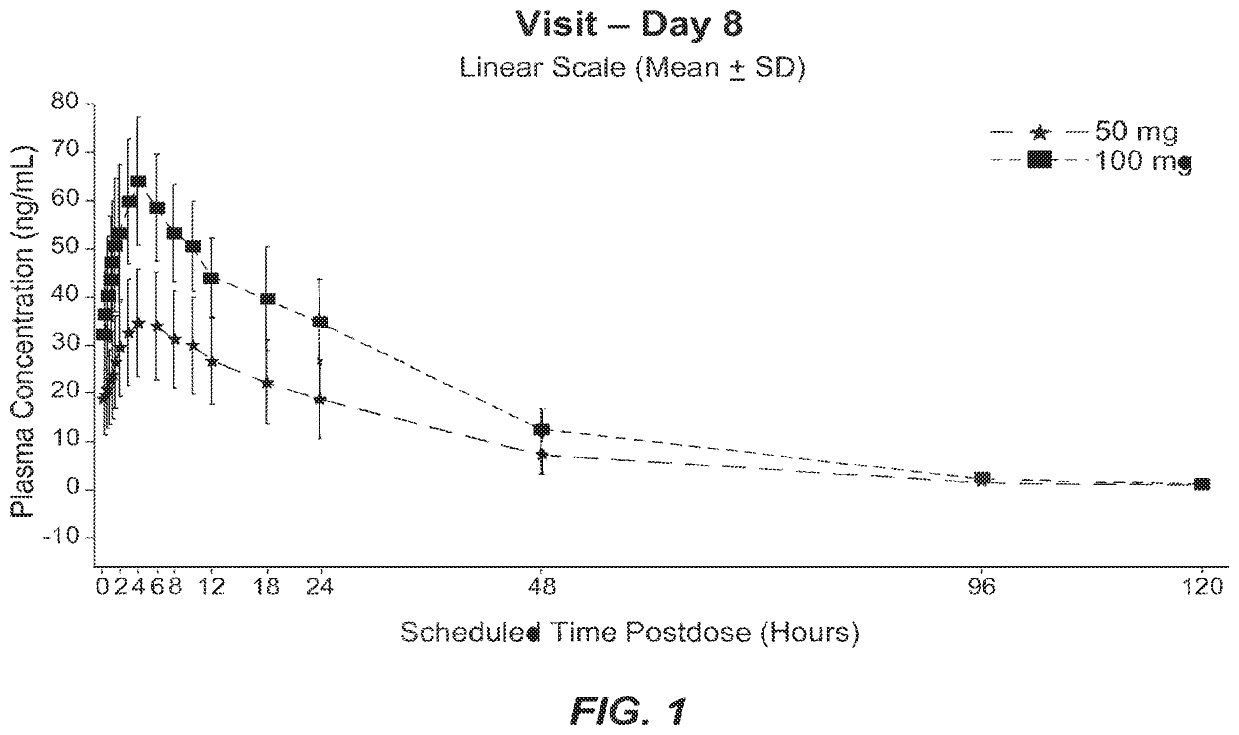Treatment of hyperkinetic movement disorders
a hyperkinetic movement and disorder technology, applied in the direction of nervous disorders, medical preparations, pharmaceutical delivery mechanisms, etc., can solve the problems of hyperkinetic movement disrupting normal speech, limb movements, walking and balance, self-injury, etc., and achieves the effects of reducing the risk of injury, and improving the quality of li
- Summary
- Abstract
- Description
- Claims
- Application Information
AI Technical Summary
Benefits of technology
Problems solved by technology
Method used
Image
Examples
example 1
Human Clinical Trials—NBI-98854
[0095]Clinical data from TD subjects administered repeated doses of (S)-2-amino-3-methyl-butyric acid (2R,3R,11bR)-3-isobutyl-9,10-dimethoxy-1,3,4,6,7,11b-hexahydro-2H-pyrido[2,1-a]isoquinolin-2-yl ester from 12.5 mg to 100 mg per day indicates the drug is generally well tolerated. Efficacy is related to the concentrations of the active metabolite [+]α-dihydrotetrabenazine. Exposure-response analysis indicates that a concentration of 30 ng / mL in plasma is an appropriate target. Exposures above 60 ng / mL in plasma afford little incremental benefit but increase the risk of adverse events reflecting extension of VMAT2 pharmacology. Exposures below ng / mL are suboptimal across the general TD population.
[0096]Observed exposure and Abnormal Involuntary Movement Scale (AIMS) derived from video ratings from a Phase 2 clinical study of (S)-2-amino-3-methyl-butyric acid (2R,3R,11bR)-3-isobutyl-9,10-dimethoxy-1,3,4,6,7,11b-hexahydro-2H-pyrido[2,1-a]isoquinolin-2-yl...
example 2
Maintenance of Plasma Threshold Concentration of [+]α-HTBZ in NBI-98854 Treated Patients
[0099]NBI-98854 was administered orally once daily at a dose of 50 mg or 100 mg for 8 days to patients in a multiple-dose cohort (n=13 for 50 mg dosage group; n=4 for 100 mg dosage group). Individual subject plasma concentration data for (+)α-HTBZ was collected at scheduled times post-dose (0 hr, 2 hr, 4 hr, 6 hr, 8 hr, 12 hr, 16 hr, 24 hr, 48 hr, 96 hr, and 120 hr) on day 8 and presented as mean plasma concentration data (linear scale) (see, FIG. 1). On Day 8, median time to Tmax for (+)α-HTBZ was approximately 4.0 hours for both doses. After maximal concentration (Cmax) was attained, (+)α-HTBZ plasma concentrations appeared to decline and exhibited an apparent t1 / 2 of approximately 21 hours (50 mg dose) and approximately 19 hours (100 mg dose). As shown in FIG. 1, the 50 mg dose of NBI-98854 appeared to maintain a desired therapeutic concentration range of between about 15 to about 60 ng of (+)...
PUM
| Property | Measurement | Unit |
|---|---|---|
| therapeutic concentration | aaaaa | aaaaa |
| therapeutic concentration | aaaaa | aaaaa |
| therapeutic concentration | aaaaa | aaaaa |
Abstract
Description
Claims
Application Information
 Login to View More
Login to View More - R&D
- Intellectual Property
- Life Sciences
- Materials
- Tech Scout
- Unparalleled Data Quality
- Higher Quality Content
- 60% Fewer Hallucinations
Browse by: Latest US Patents, China's latest patents, Technical Efficacy Thesaurus, Application Domain, Technology Topic, Popular Technical Reports.
© 2025 PatSnap. All rights reserved.Legal|Privacy policy|Modern Slavery Act Transparency Statement|Sitemap|About US| Contact US: help@patsnap.com

